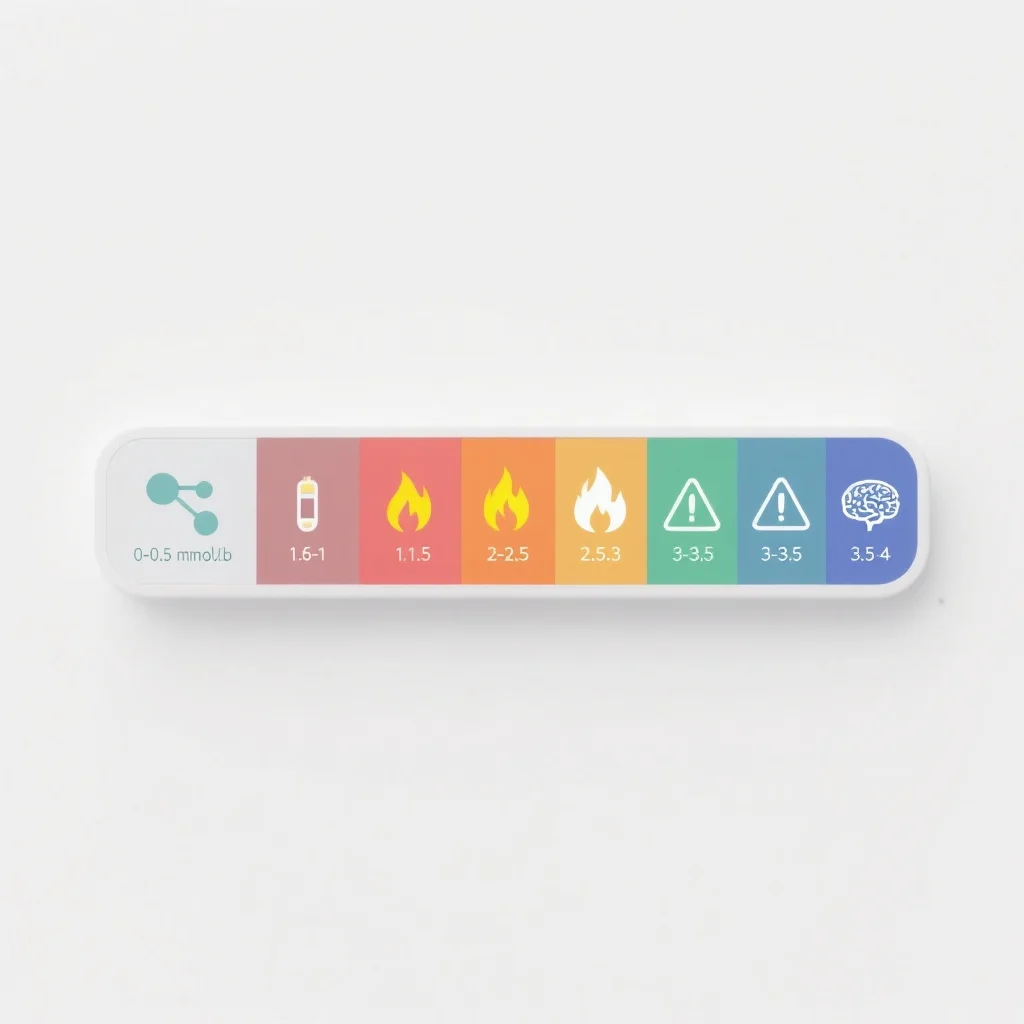Introduction
Measuring blood ketones is a powerful way to track your progress on a ketogenic diet. But what do the numbers actually mean? Ketone levels, measured in millimoles per liter (mmol/L), reflect distinct metabolic states. Understanding these ranges can help you optimize your diet, avoid pitfalls, and stay safe while reaping the benefits of ketosis.
0–0.5 mmol/L: Not in Ketosis
At this level, your body is primarily burning glucose for energy. This is the typical range for people eating a standard or high-carbohydrate diet. There may be trace amounts of ketones present, especially after fasting overnight or intense exercise, but they are not high enough to indicate nutritional ketosis.
Metabolic state:
- Glucose is the main fuel source.
- Insulin levels are higher.
- Fat burning is minimal.
- No significant ketone production.
0.5–1.0 mmol/L: Light Ketosis
This range marks the beginning of nutritional ketosis. Your body has started to shift from burning glucose to burning fat for fuel, and the liver is producing measurable ketones. Many people reach this range after 1–3 days of carbohydrate restriction or fasting.
Metabolic state:
- Increased fat burning.
- Lower insulin levels.
- Some brain and muscle cells begin using ketones for energy.
- Appetite may start to decrease.
1.0–1.5 mmol/L: Moderate Ketosis
This is the “sweet spot” for many people on a ketogenic diet. Fat burning is robust, and ketones are providing a significant portion of the brain’s energy needs. Many report increased mental clarity, stable energy, and reduced hunger in this range.
Metabolic state:
- Strong fat burning.
- Ketones are a major energy source for the brain and muscles.
- Blood sugar is stable and low.
- Appetite suppression is more pronounced.
- Ideal for weight loss and metabolic health.
1.5–2.0 mmol/L: Deep Ketosis
This range is often targeted for therapeutic purposes, such as managing epilepsy, neurological conditions, or for those seeking maximum fat loss. The body is highly efficient at producing and using ketones, and glucose requirements are minimal.
Metabolic state:
- Maximum fat burning.
- Brain and muscles are highly adapted to ketones.
- May enhance cognitive and physical performance for some.
- Appetite is very low.
- Used in clinical settings for certain medical conditions.
2.0–2.5 mmol/L: High Ketosis
At this level, the body is producing a large amount of ketones, often seen during extended fasting, strict ketogenic diets, or in those who are highly keto-adapted. While still considered safe for most healthy individuals, this range is typically not necessary for general health or weight loss.
Metabolic state:
- Ketone production is high.
- The body is almost entirely fueled by fat and ketones.
- Some may experience increased diuresis (urination) and need to monitor hydration and electrolytes.
2.5–3.0 mmol/L: Very High Ketosis
This range is usually only seen in prolonged fasting, very low-calorie diets, or in therapeutic ketosis for specific medical conditions. For most people, there is no added benefit to being in this range, and it may signal the need to monitor for symptoms of excessive ketosis.
Metabolic state:
- Ketone production is very high.
- The body is running almost exclusively on ketones.
- Monitor for symptoms like nausea, fatigue, or dehydration.
3.0–3.5 mmol/L: Approaching Excess
Levels in this range are rarely necessary outside of medical supervision. While some therapeutic protocols may target this range, for most people, it can be a sign of excessive restriction or fasting. It’s important to monitor for symptoms and ensure adequate caloric and electrolyte intake.
Metabolic state:
- Ketone levels are approaching the upper safe limit for nutritional ketosis.
- Risk of dehydration and electrolyte imbalance increases.
- Watch for symptoms of malaise or gastrointestinal upset.
3.5–4.0 mmol/L: Excessive Ketosis
This range is considered excessive for most people and may indicate a risk for developing ketoacidosis, especially in those with underlying health conditions or insulin deficiency. While rare in healthy individuals, it’s important to be cautious and seek medical advice if you feel unwell.
Metabolic state:
- Ketone levels are very high.
- Risk of dehydration, electrolyte imbalance, and acidosis increases.
- Medical supervision is recommended if levels persist.
4.0+ mmol/L: Danger Zone
Ketone levels above 4.0 mmol/L are generally considered unsafe, especially if accompanied by high blood sugar, dehydration, or symptoms like nausea, vomiting, confusion, or rapid breathing. This can be a sign of diabetic ketoacidosis (DKA), a life-threatening condition that requires immediate medical attention.
Metabolic state:
- Ketone production is dangerously high.
- Risk of DKA is significant, especially for people with diabetes or insulin deficiency.
- Seek medical help immediately if you experience symptoms.
Conclusion
Understanding your ketone levels can help you fine-tune your ketogenic diet for optimal results and safety. Most people thrive in the 1.0–2.0 mmol/L range, where fat burning, mental clarity, and appetite control are maximized. Extremely high ketone levels are rarely necessary and can be dangerous in certain situations. Regular monitoring and listening to your body are key to safe and effective ketosis.




